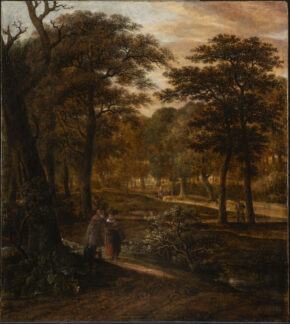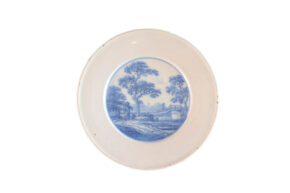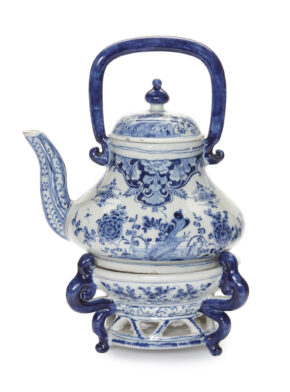[popup_trigger id=”13756″ tag=”span”]![]() [/popup_trigger]
[/popup_trigger]
Images on this website are licensed under a
Creative Commons Attribution-NoDerivs 3.0 Unported License.
OBJECT
D2207. Blue and White Pyramidal Flower Vase
Delft, circa 1695
Marked with an asterisk in blue for De Witte Ster (The White Star) factory, letter I or / and numeral 150 in blue, attributed to Dirck Witsenburgh, partial owner of the factory from 1690 – 1704
Comprising four sections: the top formed as two spreading square tiers with a bowl-shaped finial, each with a grotesque mask at the four corners issuing a tubular spout painted with floral sprigs, and with a perched bird on a sprig or bird in flight between the spouts, the lower tier with a lappet and with floral scrolls between the spouts; the two graduated square segments below each similarly formed with a grotesque mask at each corner issuing a tubular spout decorated with floral sprigs or lappets and painted between with a floral sprig or a bird perched on a sprig or in flight; the lower section with the largest tier, similarly shaped and decorated with a mask at each corner issuing a tubular spout decorated with floral sprigs and painted between with either a bird perched on a branch or a floral sprig, the canted area painted with a flowerhead and scrollwork, and raised on four scroll feet decorated with various floral borders and flanking on the center of each side the bust of a man wearing a blue doublet and forming extra supports; the bottom tier set on an architectural square base, its top painted with floral scrollwork motifs , its four sides painted with either a bird perched on a stylized rock below a fluttering insect and besides a profusion of blossoming plants, or Chinese precious objects such as a table with a ewer below two birds in flight and before a large vase with budding plants, or two birds in flight above a hare amiss floral shrubbery, or Chinese precious objects such as a table, a large teapot and a large vase below a bird in flight, all between moldings at the top and bottom variously patterned with borders of leaves and ribbons, petal tips, dentils and a flowering vine, all raised on four square ball feet painted with floral sprigs.
DIMENSIONS
Height: 54.4 cm. (21.4 in.)
PROVENANCE
Property of the Shelter Island Historical Society, sold to benefit the Museum Collections Program, probably since 1983
LITERATURE
Janet Roach (ed.), Delftware from the Gill Patterson Collection at the Shelter Island Historical Society, Shelter Island Historical Society, 2012, p. 7
NOTE
In their constant search for innovation and for expansion of their range, around 1680 the Delft potters began to develop new forms of vases. The most common types were table vases in the form of tureens and baskets, or stacks of round basins. But far rarer and more extravagant were the so-called ‘flower pyramids’, or as they were called in the seventeenth century, ‘flowerpots with pipes’. These monumental obelisk-shaped vases, which consisted of four or more spouted spheres of decreasing size stacked on top of one another, were predominantly made for the Dutch and English courts of King William III and Queen Mary II. These tiered pyramidal vases grew ever taller and more complex in shape over the years. The base for the pyramid is formed by a classical square pedestal, frequently standing on either four ball feet, lion’s-paw feet or complete lions, as in the vases in the collection of the Victoria and Albert Museum in London (inv. nos. C.96-1981, C.19-1982). The main scene, which is painted on the pedestal, often depicts Chinese scenes mixed with western imagery, but a number of vases were decorated with elements of seventeenth-century garden architecture. The painters often referred to the function of the object in their imagery, namely to display flowers. The pedestal of the present flower pyramid by De Witte Ster (The White Star) factory are decorated in this manner, with Chinese imageries alternated with panels of birds within floral scenes as a reference to the use of the objects.
The transition between the pedestal and the pyramid-shaped section is formed by a number of scrolls and crouching lions, lizards or animals resembling water buffaloes. But also busts of male figures, such as the figures with a more European or even Dutch appearance, in the present vase by De Witte Ster, support the pyramid tower. There are also other pyramidal flower vases known with busts of black men and volutes with sphinxes.
The repetition of the square tiers required the artists to repeat the same patterns and decorations, but to make them smaller and smaller towards the top. Often at all of the corners grotesque heads molded in relief issue spouts from their gaping jaws. The spouts were placed toward the bottom of each tier so that the flower stems could touch the water in the tier, which itself formed a small reservoir.
That these flower pyramids were constructed of stacked tiers is no wonder, since it would have been technically impossible for the potters to make and fire such tall earthenware vases in one piece without the risk of their collapsing in the kiln. Unfortunately a well formed model did not guarantee that the pyramid would be perfect, and the potters had to make sure that the parts fitted well both before and after the firing. During the firing process, sometimes parts of the vases collapsed or broke, a disaster that is evident on a few pedestals of which the walls slightly slumped. But the potters were clever in their methods of preventing potential problems, and they included in the interior construction of each tier a cylindrical pipe through which would be inserted a wooden stick or rod to ensure that the pyramids had additional invisible internal support. Furthermore, they realized that a structure of stacked tiers forming individual flower vases was also the most practical way of watering the flowers. Besides these practical considerations, there was also an aesthetic element.
That these flower pyramids were constructed of stacked tiers is no wonder, since it would have been technically impossible for the potters to make and fire such tall earthenware vases in one piece without the risk of their collapsing in the kiln. Unfortunately a well formed model did not guarantee that the pyramid would be perfect, and the potters had to make sure that the parts fitted well both before and after the firing. During the firing process, sometimes parts of the vases collapsed or broke, a disaster that is evident on a few pedestals of which the walls slightly slumped. But the potters were clever in their methods of preventing potential problems, and they included in the interior construction of each tier a cylindrical pipe through which would be inserted a wooden stick or rod to ensure that the pyramids had additional invisible internal support. Furthermore, they realized that a structure of stacked tiers forming individual flower vases was also the most practical way of watering the flowers. Besides these practical considerations, there was also an aesthetic element.
In the seventeenth century it was customary to display pieces of porcelain in pyramidal arrangements in or on the top of art cabinets, on wall brackets or on mantels of palace rooms. These étagères for porcelain, or so-called ’pyramids’, created an impression of great wealth and sophistication. This fashion may well have been inspired by the passion for all things Asian and by the association of the coveted Chinese ceramics with the tapering architecture of Chinese pagodas.
In all probability, molds were used in the manufacture of the vases with spouts. For angular and ribbed objects, and for handles and spouts the modelers used plaster molds, in which the clay was pressed. The resulting casts were secured individually to the object with slip, a thin, watery clay. Since during the baking process distortions or irregularities could develop, a numbering of the parts was necessary in order to avoid problems when stacking. Small differences in size usually were the result of characteristic but unpredictable shrinkage during the process of cooling in the kiln.
SIMILAR EXAMPLES
In the collection of Stichting Huizinghe ‘de Loet’, in ’s Hertogenbosch, The Netherlands, there is a pyramidal flower-holder quite similar in shape, with six tiers, of 72.5 cm (28 9/16 in.) in height. Another single flower pyramid (82.6 cm. [321⁄2 in] in height) is in the collection of the Rijksmuseum Twenthe (inv. no. Br 0001 [R 017], on loan from the Stichting Oudheidkamer ‘Riesen’ te Rijssen). It is marked LVE for Lambertus van Eenhoorn of De Metaale Pot factory, and the pedestal is painted with European- style floral decoration and mythological scenes of the goddess Flora and the god Bacchus amidst putti. Interestingly, a pedestal with the identical decoration and marked LVE was sold at Christie’s Amsterdam on June 7th 1994, lot no. 507, and given that flower vases always were made in pairs, it is very possible that this incomplete flower vase was originally the pendant to the one in the Rijksmuseum Twenthe. Another pair of flower vases marked with an asterisk for De Witte Ster factory was on sale on April 28- 29th in 1908 at Frederik Muller & Cie in Amsterdam. A pair of pyramidal flower vases, marked for Lambertus van Eenhoorn, is in the Rijksmuseum, Amsterdam, inv. no. BK-14852-A/B. A second pair, marked for De Witte Starre, published by Aronson 2016, is in a Private Collection. A single pyramidal flower vase, marked WB, is in Musée du Louvre, Paris, inv. no. OA 4040.






